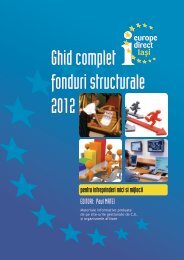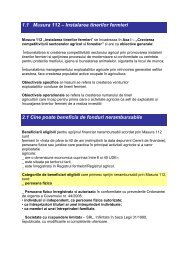2012 - Europe Direct Iasi
2012 - Europe Direct Iasi
2012 - Europe Direct Iasi
Create successful ePaper yourself
Turn your PDF publications into a flip-book with our unique Google optimized e-Paper software.
EUROINVENT <strong>2012</strong><br />
as input. The number of intervals, the number of averaged<br />
values in each interval and the standard deviation of the<br />
Gaussian function are user defined parameters. Modeling results<br />
consist of the list of fuzzy interpolation function coefficients.<br />
The approximated values and errors for all the measurements<br />
points are also computed.<br />
The 3 rd order spline model uses a list of measured attenuation<br />
values for different values of the atmospheric visibility and the<br />
wavelength as input. The number of interpolation points and the<br />
number of averaged values are user defined parameters.<br />
Modeling results consist of the spline function coefficients. The<br />
approximated values and errors for all the measurements points<br />
are also computed.<br />
10.4.<br />
Title Method and System for Time Interval Measuring<br />
Authors Horia-Nicolai Teodorescu, Mircea Hulea<br />
Institution Gheorghe Asachi Technical University of <strong>Iasi</strong><br />
Patent no. Patent application no: 00157/ 02. 2011<br />
Description<br />
The invention introduces a hybrid method for high-precision<br />
time intervals measurements suitable for implementation on lowcost<br />
microcontrollers such as PIC18FXXX series from<br />
MICROCHIP. Using the build-in ADC and TIMER, the method<br />
combines the advantages of direct counting and time-to-voltage<br />
conversion (TtV) time measuring methods. The direct counting<br />
method is suitable for longer time intervals measuring, but it is<br />
less precise while the time-to-voltage conversion increases the<br />
precision of the time measurements being applicable for<br />
measuring shorter time intervals. The microcontroller measures<br />
the intervals by determining the elapsed time between the rising<br />
and the falling edges of a digital signal that represents the event.<br />
Because the event signal and the counter clock are not<br />
synchronous, we used the TtV method for compensating this<br />
misalignment. The event signal transitions are detected using the<br />
Class 10<br />
141
















